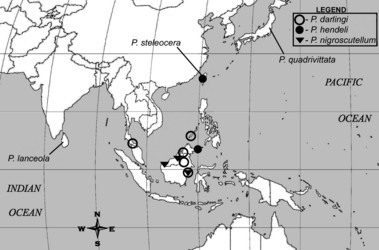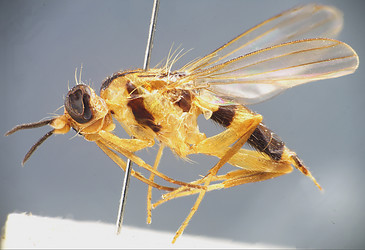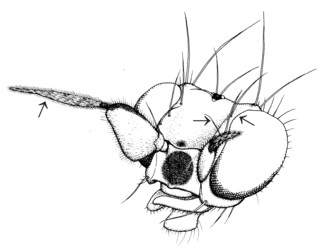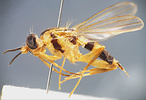Phylloclusia
Owen Lonsdale and Steve Marshall


This tree diagram shows the relationships between several groups of organisms.
The root of the current tree connects the organisms featured in this tree to their containing group and the rest of the Tree of Life. The basal branching point in the tree represents the ancestor of the other groups in the tree. This ancestor diversified over time into several descendent subgroups, which are represented as internal nodes and terminal taxa to the right.

You can click on the root to travel down the Tree of Life all the way to the root of all Life, and you can click on the names of descendent subgroups to travel up the Tree of Life all the way to individual species.
For more information on ToL tree formatting, please see Interpreting the Tree or Classification. To learn more about phylogenetic trees, please visit our Phylogenetic Biology pages.
close boxIntroduction

Distribution of Phylloclusia species. © Owen Lonsdale
Phylloclusia Hendel, 1913 species are slender and yellow with dark stripes and spots and are among the largest Clusiidae (4.5-7.3 mm in length) (Lonsdale & Marshall, 2006). The genus includes six species found in Japan, Taiwan and Southeast Asia, while its sister group, Tetrameringia McAlpine, 1960 (also found in Japan) has a more southerly distribution, with species described from Madagascar, South Africa, Malawi and eastern Australia (Barraclough, 2000, 2002; McAlpine, 1960; Sueyoshi, 2006; Stuckenberg, 1973).
Little is known of the biology of Tetrameringia and Phylloclusia, but P. darlingi Lonsdale & Marshall has been collected in a log emergence trap, and specimens of Tetrameringia have been collected around creeks and small streams in shaded areas (McAlpine, 1960). Australian Tetrameringia have also been collected by sweeping over a moist stream bed in an otherwise dry forest. Immature stages are unknown.
Characteristics
The defining synapomorphies of Phylloclusia include the following: one pair of lateral scutellar bristles; anterior dorsocentral no more than half length of posterior dorsocentral; posterior 1/3 of scutum shiny between dorsocentral bristles; frons shiny, slightly constricted posteriorly, and with anterior margin produced as an elevated ridge; lower ¾ of face brown (sometimes appearing as a central spot); notum elongate with postpronotum bulging (less so in P. lanceola spec. nov.). Phylloclusia species also have very long prescutellar acrostichal bristles and no dorsal preapical tibial bristles, and the Japanese and Southeast Asian species have a laterally compressed arista (also found in the European Hendelia beckeri Czerny), a long triangular first flagellomere, yellow bristles and a carinate face (Lonsdale & Marshall, 2006).
Phylogenetics
Phylloclusia is considered the sister-group to Tetrameringia in the Clusiinae on the basis of male and female genitalic synapomorphies: posterior margin of male sternite 6 setose; surstylus small, thin and subtriangular; inner surface of surstylus without basal projection; distiphallus broken medially and reflexed; ventral shield of phallapodeme raised from shaft (almost entirely reversed in P. quadrivittata); spermatheca pigmented, irregularly-shaped and with minute transverse grooves (smooth and spherical in T. borealis Sueyoshi); spermathecal duct with subbasal attachment to spermatheca (Lonsdale & Marshall, 2006). Loss of the hypandrial bristles may be an additional synapomorphy of these genera, but they are also absent in Clusia.
Externally, both genera differ from other Clusiidae by having inclinate anterior fronto-orbital bristles, two pairs of dorsocentral bristles, a well-developed postvertical bristle, one pair of vibrissae, a small M1,2 ratio (1.9-2.5), bristles on the posterodorsal surface of the fore femur and no interfrontal or dorsal preapical tibial bristles. Most species in these genera also usually lack a subnotal stripe and have an irregular row of ventral ctenidial bristles on the male fore and mid femora (Lonsdale & Marshall, 2006).
References
Barraclough, D.A. 2000. The identity of Strongylophthalmyia Heller species (Diptera: Schizophora: Strongylophthalmyiidae) described from the Afrotropical Region, and their transfer to the family Clusiidae. Annals of the Natal Museum, 41: 103-106.
Barraclough, D.A. 2002. A new species of Tetrameringia McAlpine (Diptera: Schizophora: Clusiidae) from Malawi, the third species from the Afrotropical Region. African Invertebrates, 43: 5-10.
Hendel, F. 1913. Acalyptrate Musciden. Clusiinae. Supplementa Entomologica, 2: 77-81.
Lonsdale, O. & Marshall, S.A. 2006. Revision of the genus Phylloclusia (Diptera: Clusiidae: Clusiinae). The Canadian Entomologist (accepted for publication).
McAlpine, D.K. 1960. A review of the Australian species of Clusiidae (Diptera: Acalyptrata). Records of the Australian Museum, 25: 63-94.
Stuckenberg, B.R. 1973. New and little-known Clusiidae (Diptera) from South Africa and Mocambique. Annals of the Natal Museum, 21(3): 579-593.
Sueyoshi, M. 2006. Species diversity of Japanese Clusiidae (Diptera: Acalyptrata) with description of 12 new species. Annales de la Société Entomologique de France, 42(1): 1-26.
Title Illustrations

| Scientific Name | Phylloclusia |
|---|---|
| Location | Indonesia |
| Specimen Condition | Dead Specimen |
| Sex | Female |
| Copyright |
© Steve Marshall

|
| Scientific Name | Phylloclusia steleocera Hendel |
|---|---|
| Location | Taiwan |
| Life Cycle Stage | Adult |
| Body Part | Head |
| Image Use |
 This media file is licensed under the Creative Commons Attribution-NonCommercial License - Version 3.0. This media file is licensed under the Creative Commons Attribution-NonCommercial License - Version 3.0.
|
| Copyright |
© Owen Lonsdale

|
About This Page
Owen Lonsdale

Canadian National Collection of Insects, Arachnids & Nematodes
Steve Marshall

University of Guelph, Canada
Correspondence regarding this page should be directed to Owen Lonsdale at
Neoxabea@hotmail.com
and Steve Marshall at
samarsha@uoguelph.ca
Page copyright © 2011 Owen Lonsdale and Steve Marshall
 Page: Tree of Life
Phylloclusia.
Authored by
Owen Lonsdale and Steve Marshall.
The TEXT of this page is licensed under the
Creative Commons Attribution-NonCommercial License - Version 3.0. Note that images and other media
featured on this page are each governed by their own license, and they may or may not be available
for reuse. Click on an image or a media link to access the media data window, which provides the
relevant licensing information. For the general terms and conditions of ToL material reuse and
redistribution, please see the Tree of Life Copyright
Policies.
Page: Tree of Life
Phylloclusia.
Authored by
Owen Lonsdale and Steve Marshall.
The TEXT of this page is licensed under the
Creative Commons Attribution-NonCommercial License - Version 3.0. Note that images and other media
featured on this page are each governed by their own license, and they may or may not be available
for reuse. Click on an image or a media link to access the media data window, which provides the
relevant licensing information. For the general terms and conditions of ToL material reuse and
redistribution, please see the Tree of Life Copyright
Policies.
- First online 25 August 2005
- Content changed 24 November 2009
Citing this page:
Lonsdale, Owen and Steve Marshall. 2009. Phylloclusia. Version 24 November 2009 (under construction). http://tolweb.org/Phylloclusia/27671/2009.11.24 in The Tree of Life Web Project, http://tolweb.org/









 Go to quick links
Go to quick search
Go to navigation for this section of the ToL site
Go to detailed links for the ToL site
Go to quick links
Go to quick search
Go to navigation for this section of the ToL site
Go to detailed links for the ToL site